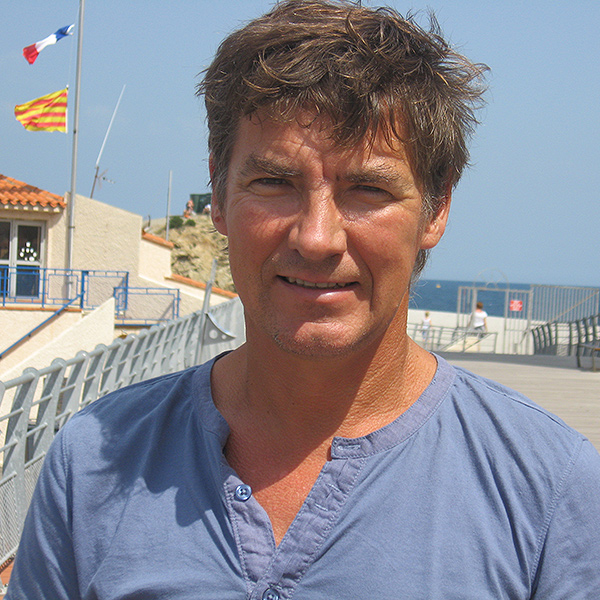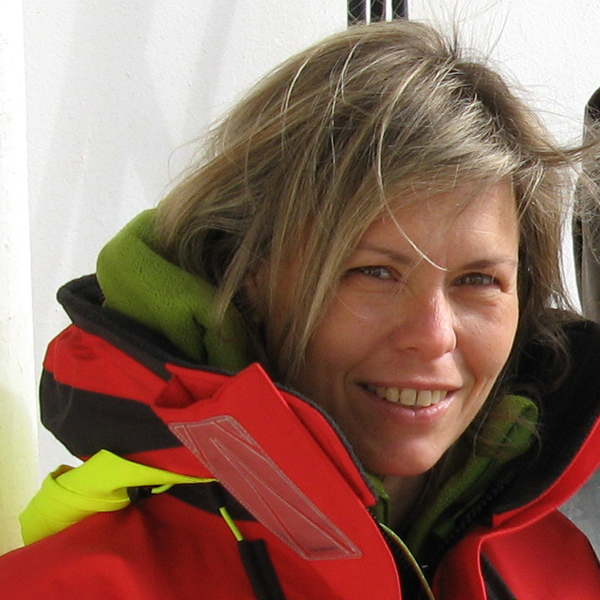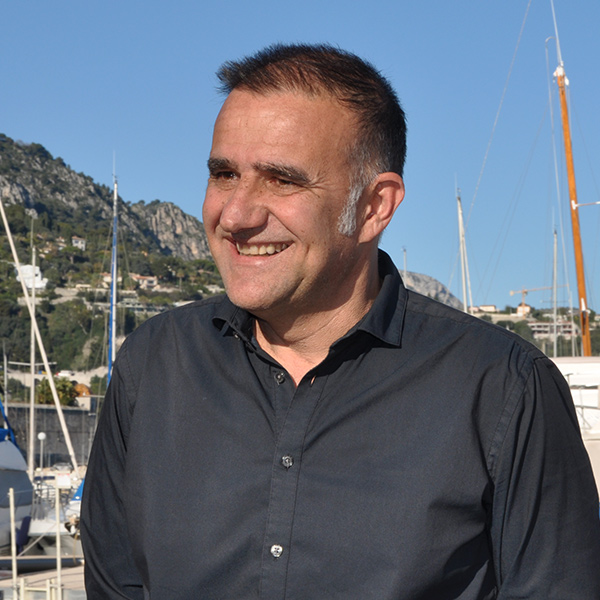RESTRICTED ACCESS
Key Scientists
INTERVIEW OF Stéphane BLAIN
during SOCLIM kickoff ....
Stéphane BLAIN
PRESENTATION
Stéphane Blain received his Ph.D. in chemical oceanography from the University of Brest in 1992. In 1993, he served as a post doc at the Moss Landing Marine Laboratories during the preparation of IRONEX1. He is actually professor of chemical oceanography at the University Pierre et Marie Curie (Paris). He is working at the Marine station of Banyuls sur Mer, where he has founded and directed the Microbial Oceanography Laboratory (2010-2013), a research unit in partnership with the UPMC and the CNRS. His research interests are the functioning of the biological pump of CO2 in the ocean with focus on iron biogeochemistry and the Southern Ocean. He is also involved in the development of new analytical tools and methods for in-situ chemical oceanography.
He has initiated the project KEOPS (KEOPS: Kerguelen Ocean and Plateau compared study) ten years ago. The main objective of KEOPS is to study the impact of natural iron fertilization of the Southern Ocean. KEOPS is international project that gathered researchers from 10 French laboratories and foreign colleagues from different nations (Australia, Belgium, Chili, The Netherlands, South Korea, USA, UK). The first phase of this project was conducted in 2004-2009 and has produced more than 50 publications. The second phase (2011-2014) is currently underway with the publications of the papers related to the KEOPS2 cruise. As principal investigator of KEOPS, He has co-organized two special sessions with colleagues of the National Oceanographic Center of Southampton (OSM, Hawaii 2006) and with colleagues of the Alfred Wegener Institute (ASLO meeting, Orlando 2013). He was involved in the SCOR WG and invited to international workshops and conferences.
During the past 20 years he has been very interested in observing systems. In 1997, he has organized an international symposium on marine analytical chemistry for the monitoring of oceanographic research. He has participated to the first development of nutrient in situ chemical analyzers and to the deployments of biogeochemical sensors on buoys. Recently, He has used fluorescence sensors mounted on elephant seals of Kerguelen to produce the first two dimensional climatology of chlorophyll in a region of the Southern Ocean.
SELECTED PUBLICATIONS RELEVANT TO THIS PROPOSAL
Stéphane Blain has published 50 papers, which have been cited 2204 times. His h-index is 23.
- Blain S., Sophie R., Xiaogang X., Claustre H. and Guinet C. (2013) Seasonality in Chlorophyll and light-mixing regime in the iron fertilized Southern Ocean. Geophysical Research Letter, vol. 40, 1–5.
- Bozec,Y., Merlivat,L., Baudoux,A. C., Beaumont,L., Blain,S., Bucciarelli,E., Danguy,T., Grossteffan,E., Guillot,A., Guillou,J., Repecaud,M., Treguer,P. (2011). Diurnal to inter-annual dynamics of pCO2 recorded by a CARIOCA sensor in a temperate coastal ecosystem (2003-2009). Marine Chemistry, 126, 13-26
- Blain, S., B. Quéguiner, L. Armand, S. Belviso, B. Bombled, L. Bopp, A. Bowie, C. Brunet, K. Brussaard, F. Carlotti, U. Christaki, A. Corbière, I. Durand, F. Ebersbach, J.L. Fuda, N. Garcia, L.J.A. Gerringa, F.B. Griffiths, C. Guigue, C. Guillerm, S. Jacquet, C. Jeandel, P. Laan, D. Lefèvre, C. Lomonaco, A. Malits, J. Mosseri, I. Obernosterer, Y.H. Park, M. Picheral, P. Pondaven, T. Remenyi, V. Sandroni, G. Sarthou, N. Savoye, L. Scouarnec, M. Souhault, D. Thuillers, K.R. Timmermans, T. Trull, J. Uitz, P. Van-Beek, M.J.W. Veldhuis, D. Vincent, E. Viollier, L. Vong, and T. Wagener, Effect of natural iron fertilisation on carbon sequestration in the Southern Ocean. Nature, 2007, 1070-1074.
- Jouandet M. P., Trull T. W., Guidi L., Picheral M., Ebersbach F., Stemmann L., Blain S. (2011). Optical imaging of mesopelagic particles indicates deep carbon flux beneath a natural iron-fertilized bloom in the Southern Ocean. Limnology and Oceanography, 56, 3, 1130-1140.
- Boyd, P.W., T. Jickells, C. Law, S. Blain, E.A. Boyle, K.O. Buesseler, K.H. Coale, J.J. Cullen, H.J.W. De Baar, M. Follows, M. Harvey, C. Lancelot, M. Levasseur, D.A. Pollard, R.B. Rivkin, J.L. Sarmiento, V. Schoemann, V. Smetacek, S. Takeda, A. Tsuda, D.R. Turner, and A. Watson, (2007) A synthesis of mesoscale iron-enrichment experiments 1993-2005: key findings and implications for ocean biogeochemistry. Science, 2007, 315, 612-617.
PROFESSIONAL POSITIONS
1986-1992 Research assistant URA CNRS 322, Université de Bretagne occidentale
1993 Post-doctoral position Moss Landing Marine Laboratory CA USA
1993-1996 Research assistant, Université de Bretagne Occidentale
1996-2003 Associate professor, Université de Bretagne Occidentale
2003-2007 : Professor Université de Marseille II
2008- : Professor Université Pierre et Marie Curie. PARIS
INTERVIEW OF Sabrina SPEICH
during SOCLIM kickoff ....
Sabrina SPEICH
PRESENTATION
Sabrina Speich is Professor of Geosciences at the Ecole Normale Supérieure in Paris, France. She studied Physics in Italy at the University of Trieste (Italy), at the CERN in Geneva (Switzerland), and at the University of Paris 6. She received a PhD in Physical Oceanography from the University of Paris 6 (France) in 1992, then was postdoctoral researcher at the Department of Atmospheric Sciences at University of California, Los Angeles (UCLA, USA) from 1992 to 1994. She was researcher at the CNRS (Paris, France) in 1995, then became Professor at University of Brest (France) until 2013. She was invited Professor at the University of Cape Town (South Africa) in 2001.
Prof. Speich' research interests concern the uncovering and understanding of ocean dynamics and its role on climate variability and change. She is a world-recognized expert in ocean modelling as well as in organizing wide programs of in situ observations. She is recently focusing her research on scale-interactions in ocean dynamics and how they affect the global ocean circulation, air-sea interactions and ecosystems. She initiated and led many field experiments to study ocean processes as well as ocean variability and changes. She pioneered the use of Argo floats to observe the ocean.
Prof. Speich has co-authored 60 publications in top-tier peer-reviewed journals (h-index=21 and 1230 citations as of December 2013), has given over 30 invited lectures and seminars, and contributed to more than 150 presentations at national and international meetings. He has supervised 15 graduate students and post-graduate fellows and teaches Physical Oceanography and Climate Sciences at the undergraduate and graduate level. Prof. Speich is currently co-chairing and has chaired or co-chaired some international programs within the CLIVAR program, The International Polar Year initiative and the European Research Projects framework and ANR. She has been serving on a number of national and international committees and review panels. She has been convener, organizer, or program committee member for many international scientific meetings.
SELECTED PUBLICATIONS RELEVANT TO THIS PROPOSAL
Stéphane Blain has published 50 papers, which have been cited 2204 times. His h-index is 23.
- Meinen, C. S., S. Speich, R. C. Perez, S. Dong, A. R. Piola, S. L. Garzoli, M. O. Baringer, S. Gladyshev, and E. J. D. Campos, Temporal variability of the Meridional Overturning Circulation at 34.5°S: Results from two pilot boundary arrays in the South Atlantic, J. Geophys. Res., 118 (12), 6461-6478, doi:10.1002/2013JC009228, 2013
- Rusciano, E., S. Speich and M. Ollitrault, 2012 : Antarctic Intermediate Water dynamics, budget and fluxes. Interocean exchanges South of Africa. J. Geophys. Res. doi:10.1029/2012JC008266, in press
- Swart, S., S. Speich, 2010: A satellite altimetry based Gravest Empirical Mode South of Africa. Part II: 1992-2008 Heat, Salt andMass Transport variability and changes. J. Geophys. Res., 115, C03003, doi:10.1029/2009JC005300
- Speich, S., B. Blanke, et G. Madec, 2001 : Warm and cold water paths of a GCM thermohaline conveyor belt. Geophys. Res. Lett., 28, 311-314
- Speich, S., B. Blanke, and W. Cai, 2007: Atlantic Meridional Overturning and the Southern Hemisphere Supergyre. Geophys. Res.Lett., VOL. 34, L23614, doi:10.1029/2007GL031583
- Speich, S., H. Dijkstra, M. Ghil, 1995 : Successive bifurcations in a shallow-water modelapplied to the wind-driven ocean circulation.Nonlinear Processes in Geophysics, Vol. 2, pp 241-268
SELECTED ACTIVITIES / ANIMATION / AWARDS
Since Jan. 2014: CLIVAR Atlantic Panel member
Since 2012: SCAR Panel member
2005-2012: Southern Ocean CLIVAR/CliC/SCAR Panel member
2013: Guest Editor of Journal of Marine Science special issue for Tracers of physical and biogeochemical processes, past changes and ongoing anthropogenic impacts: 43rd International Liege Colloquium on Ocean Dynamics
2010‐2012: Guest Editor for OceanSciences special issue for the BONUS-GoodHope International Polar Year Project
2007-2014: Co-organizer of seven international meetings on the South Atlantic and Southern Ocean research
2008-2014 Co-convener of various conferences sessions for the AGU, SCAR sessions
Since 2004, PI of 150 Argo floats deployment, validation and calibration of profiles data
Supervision 21 students and 7 post‐docs
PI of the Clivar GoodHope Project (since 2003) and BONUS-GoodHope (50 days, 72 scientists) cruises
Co-PI of the Clivar SAMOC program (since 2007)
SYNERGISTIC ACTIVITIES
Since the early 2000s, Sabrina Speich started to coordinate the scientific observing efforts in the Southern Ocean. In 2001, she spent one year at the University of Cape Town, South Africa as invited professor. This visit led to the construction of the CLIVAR GoodHope project strategy and objectives. The project started officially in 2003. Prof. Speich was then invited to be part of the Southern Ocean CLIVAR/CliC/SCAR scientific panel to help coordinate the observing activity in the Southern Ocean. This led to a very organized and coordinated observing effort within the International Polar Year (2008-2009), during which Prof. Speich led one of the most complete observing project of the Southern Ocean, BONUS-GoodHope. This project federated 27 international research units and institutes. It gathered more than one hundred scientists from different scientific fields of Oceanography, Atmospheric Sciences and Geophysics.
In 2007 Prof. Speich initiated together with Drs S. Garzoli (NOAA, USA) and AL. Piola (SNHA, Argentina) a new international initiative dedicated to build an integrated observing system for the South Atlantic sector of the Southern Ocean, SAMOC. This initiative evolved successfully and today is almost completed in terms of deep mooring arrays and repeated observations. SAMOC has been approved by CLIVAR and the Southern Ocean Observing System (SOOS). This initiative gathers many institutions from many countries (France, South Africa, Argentina, Brazil, Uruguay, USA, Russia, Spain, Germany, United Kingdom).
This year Prof. Speich has integrated the Atlantic CLIVAR Panel.
Within the Laboratoire de Physique de l’Océan (LPO) in Brest, Prof. Speich was leading one of the three teams of the laboratory.
Prof. Speich is highly concerned by outreach and science dissemination to a wider audience. In addition to her teaching activity within the Brest University and the Ecole Normale, she gave many talks for the large public; participated to the making of a documentary on the ocean’s currents (Voyage au centre de la mer; Directed by M. Jampolski. Produced by MC4, Arte and Radio Canada), and she wrote or collaborated in the writing of numerous outreach articles.
INTERVIEW OF Hervé CLAUSTRE
during SOCLIM kickoff ....
Hervé CLAUSTRE
PRESENTATION
Hervé Claustre got his PhD in 1987 and, after a post-doc at Plymouth Marine Laboratory, became CNRS Research Associate (1990) and then CNRS senior scientist at LOV. His research activities can be summarized as follows: To develop interdisciplinary approaches at the frontiers of marine biology, chemistry and optics for the study and understanding of biogeochemical processes ranging from the small to the global scale to address the variability of stocks and fluxes of matter in the upper ocean in the context of global change. Within this broad topic, his scientific contributions can be classified in three main groups.
- (1) the development of a research field based on HPLC techniques for measuring phytoplankton pigments and their application through chemotaxinomic investigations (pigments used as bio-markers of phytoplankton communities)
- (2) the development of new observational approaches at the interface of marine optics (theoretical and experimental, in situ and remote sensing) and biogeochemistry.
- (3) Since 2003, and as a natural extension of his work, Hervé Claustre is pursuing investigation of biogeochemical processes at presently unresolved scales or in poorly observed oceanic areas. For that purpose, he dedicates a large part of his effort to develop new observational techniques based on gliders and profiling floats. (http://www.oao.obs-vlfr.fr)
SELECTED PUBLICATIONS RELEVANT TO THIS PROPOSAL
Hervé Claustre has published more than 100 papers, which have been cited more than 5000 times. His h-index is 39.
- Claustre, H., Antoine, D., Boehme, L., Boss, E., D'Ortenzio, F., Fanton D’Andon, O., Guinet, C., Gruber, N., Handegard, N.O., Hood, M., Johnson, K., Lampitt, R., LeTraon, P.-Y., Lequéré, C., Lewis, M., Perry, M.-J., Platt, T., Roemmich, D., Testor, P., Sathyendranath, S., Send, U., & Yoder, J. (2010). "Guidelines Towards an Integrated Ocean Observation System for Ecosystems and Biogeochemical Cycles" in Proceedings of OceanObs’09: Sustained Ocean Observations and Information for Society (Vol. 1), Venice, Italy, 21-25 September 2009, Hall, J., Harrison, D.E. & Stammer, D., Eds., ESA Publication WPP-306, doi:10.5270/OceanObs09.pp.14
- Xing, X., Morel, A., Claustre, H., Antoine, D., D'Ortenzio, F., Poteau, A., Mignot, A. (2011). Combined processing and mutual interpretation of radiometry and fluorimetry from autonomous profiling Bio-Argo Floats. The retrieval of Chlorophyll a, Journal of Geophysical Research, 116, C06020, doi:10.1029/2010JC006899.
- Guinet, C., X. Xing, E. Walker, P. Monestiez, S. Marchand, B. Picard, T. Jaud, M. Authier, C. Cotté, A. C. Dragon, E. Diamond, D. Antoine, P. Lovell, S. Blain, F. D'Ortenzio, and H. Claustre (2013). Calibration procedures and first data set of Southern Ocean chlorophyll-a profiles collected by elephant seal equipped with a newly developed CTD-fluorescence tags. Earth System Science Data, 5, 15–29, 2013 www.earth-syst-sci-data.net/5/15/2013/ doi:10.5194/essd-5-15-2013
- Johnson, K.S., Berelson, W.M., Boss, E.S., Chase, Z., Claustre, H., Emerson, S.R., Gruber, N., Körtzinger, A., Perry, M.J. and S.C. Riser (2009). Observing biogeochemical cycles at global scales with profiling floats and gliders: prospects for a global array. Oceanography, 22(3), 216-225.
SELECTED ACTIVITIES / ANIMATION / AWARDS
2000‐2003: Associated editor for Journal of Geophysical Research‐Ocean
2008: Editor of the Biogeosciences special issue (30 papers published) for the Biogeochemistry and Optics South Pacific Experiment (BIOSOPE)
1999-2005: Co-Organizer of three international HPLC intercomparison exercises (NASA funds)
2008 AGU‐ASLO‐TOS meeting, Orlando, FL. Organizing Committee
2009 US OCB Floats and Gliders Workshop, Moss Landing, CA. Steering committee
Supervision 13 students and 4 post‐docs
PI of the PROSOPE (32 days, 28 scientists) and BIOSOPE (55 days, 35 scientists) cruises
CNRS Silver Medal (2005)
ERC advanced grant (2010‐2014)
SYNERGISTIC ACTIVITIES
Between 2001 and 2010, Hervé Claustre was Chair of the French Scientific Committee for the Oceanic Biogeochemistry Program ands thus responsible of coordinating the yearly call topics as well as the subsequent evaluation of submitted projects.
One of his strongest wishes is to help with the progressive implementation of an international Bio-Argo program, following the model of the (exemplary) Argo program. In this context, he has served or serves in several committees. He was (2008-2010) the Chair of the “Bio-Argo” Working Group of the International Ocean Color Coordinating Group (IOCCG). Presently he is member of the scientific and technical advisory group of the Euro-Argo consortium, member of the Argo Science Team, member of the SCOR Unesco Working group “Quality Control Procedures for Oxygen and Other Biogeochemical Sensors on Floats and Gliders” and member of the international committee of the SOCOM (Southern Ocean Climate Observation and Modeling) program. He has led several sessions at international meetings (e.g. AGU/ASLO/TOS) on “new science applications” based on floats and gliders.
In 2004, Hervé Claustre was the PI of the international BIOSOPE cruise [Biogeochemistry and Optics South Pacific experiment, supported by French, European and US (NASA) agencies]. This 2-month cruise with 35 scientists onboard realized a 8000 km transect from the Marquesas Islands to Chile, crossing the unknown (desert) waters associated with the South Pacific Gyre. The BIOSOPE project focused on Ocean Optics (satellite validation), biogeochemistry and molecular biology. To date, more than 85 papers using the BIOSOPE data have been published among which a special issue in Biogeosciences (35 papers).
Within the Laboratoire d’Océanographie of Villefranche, Hervé Claustre is leading the Ocean Autonomous Observation (OAO: http://www.oao.obs-vlfr.fr), whose topics range from scientific analysis and valorization of data acquired by autonomous platforms to technological developments of new sensors (e.g. a Jelly fish camera) or platforms (e.g. the group is involved in the development of the SeaExplorer robot).
Hervé Claustre is highly concerned by outreach and science dissemination to a wider audience. In this context he is co-PI of the educational projects « Mon Océan & Moi » and « Adopt a float » which aims at increasing ocean literacy of large public and especially the youth (see: http://www.monoceanetmoi.com ). These projects are presently involving more and more scientists, engineers and students from the LOV in these outreach activities. Internationalization of “adopt a float” (by different classes of different countries) is presently one of the future targets of this project. This project has been endorsed by the International Oceanographic Committee of UNESCO.



